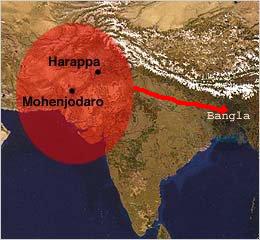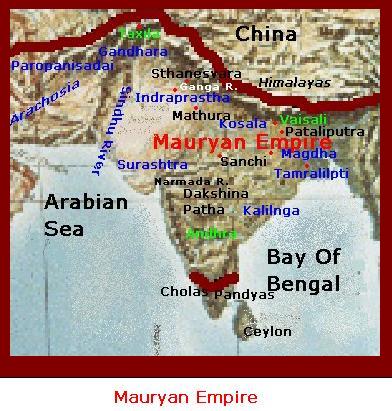Bangladesh India
In The Name Of The People
The ancient, medieval, and colonial history of Bangladesh covers a period from antiquity to 1947, when India was partitioned. So the history of Bangladesh prior to 1947 is a history of India of which Bangladesh was a part. In fact, the history of India is a history of Bengal for the large part. Today Bangladesh is an independent nation within the Indian subcontinent, but is less than half of the old Bengal or Bangla. For the first civilization of India and later empires go to Ancient India NOVO, 22nd July 2000 |
|||||
Ancient History: (NOTE: Bangla, Banga, Bengal will be used interchangably as will Bengali, Bangalee and at times Bangla) Post Gupta
After the end of the Guptas great empires rose in the south. These were the Chalukyas, Pallavas, Pandya, Chera and Chola. Chalukya The Chalukya was one of the most powerful (had taken over the powerful RastraKutas by the 10th century) even ruled Bengal for a time under the control of their king KirtiVarman (another Varman, same name as the original Bengal rulers). Chalukya empire (535-757 AD) was founded by Jayasimha (Simha or Singha was the last name of Sri Vijaya Singh(a) ) at Badami, Karnataka. (Note: later the Pal emperors of Bangla originate in Karnataka.) The empire controlled a large part of South India including Maharastra and built many famous temples. This empire also checked the advances of emperor Harsha (from Thaneswar and later Kanauj) into the South as well as stopping Arab invasions on the West. The Parsees (Zoroastrians) fleeing from persecutions from the Arabs were given asylum into India by the Chalukyas (early 8th century).
The Chalukya empire was stopped in the south by another powerful empire of the pallavas (550-750 AD). The Pallavas were the main rival of the Chalukyas. They were at war for over 3 centuries. Sometimes the Chalukyas won. In 610 AD, King Pulakeshin II (609 - 642) of the Chalukyas defeated the Pallavas under MahendraVarman. This king had also defeated Harsha at the Narmada river. Later in 642 AD, NarSimhaVarman defeated Pulakeshin II and captured Vatapi, his capital. The origin of the Pallava empire is unknown and according to the Columbia Encyclopedia it was founded in the 4th century. This may reflect an earlier reference to a Vishnugopa who fought with ChandraGupta. The Pallavas might be the old Tamils (Dramilas) from Madras where Gadadhara had established his kingdom. Interesting to note, the rulers of the Pallavas were Varmans too. It seems the Varman kings spread all over the South East India and up to Bengal, Kamarupa (Assam) and as far as Cambodia (later). Again what might be the history of the Varmans? Who were the old rulers of Kerala (Chera)?
The Cheras were friendly to the Pallavas and existed on the South west coast of India. They seem to be the other great sea-faring nation of Kerala. The Pandyas were a people from the extreme tip of Southeast India. They were ruled by Brahmins and performed Vedic sacrifices. (Are they related to the Pandus of North India?) This nation traded with the Romans and prospered. They were however not a powerful empire. But through the combined attacks of Pandyas and the Cholas the Pallava empire ended. They were established in the 6th century AD and finally were defeated by the powerful Cholas in the 11th. This was the greatest of the Southern Empires. It was founded by Vijayalaya who first captured Tanjore in 850 AD. Later in the 10th-11th centuries under Rajaraja (985 - 1014 AD) and his son Rajendra (1014 - 1044 AD) the Cholas started expanding massively. They defeated the Pallavas and conquered all South India. They conquered the Cheras, the Pandyas, Sri Lanka and Maldives. In the North they defeated Kalinga and invaded Bengal basically becoming master of all Dravirlands. Possibly like the older republican states the Chola empire was anarchist with central authority. Local self government was the norm of this empire. This empire prospered from international trade with China and southeast Asia. In the 13th century, however, the Hoysalas in the west (once tributary to the Chalukyas) and Pandyas defeated the Cholas. During the Chola rule, society was divided into Brahmins and non-brahmins and Shiva was worshipped as the Lingam (phallic). Also it was during their time that Sanskrti based languages made their appearance here. Of course local Dravir languages developed into Tamil, Telugu and Kannada while from Prakrit developed Marathi.
North India Empires were formed soon after the Guptas in the North and were constantly waging war with eachother in efforts to create great empires like the olden days. Kashmir In the early phase, Kashmir was part of Ashok's Mauryan empire. During the Mauryan era, the culture was changed from Shavia Hindu to Buddhist. After the fall of the Mauryans, it was ruled by Kushans when it became the greatest centre of Buddhism and spread Buddhism far and wide. It was then independent through the Gupta era. In the begining of the 7th century, Kashmir became a powerful Hindu kingdom under the Karkota dynasty. From this dynasty emerged Lalitaditya Muktapid, the great Kashmir conqueror. Kanauj, in North India, at the time started expansion. Kanauj conquered a large portion of North India, including Magadha (Bihar), Gaur (Western Bengal) and Banga (Central Bengal). Kanauj ruler, YashoVarman basically had destroyed the last of the Gupta empire to create his empire. However, Lalitaditya checked his dreams of creating a vast empire. He conquered Punjab (West India), and defeated Kanuj (North India). He went out of India to conquer Tibet, Ladhak, Badakshan and Iran. On the east he took Bihar, Gaur (Bengal) and Kalinga (Orissa). He took part of South India, Gujarat, Malwa, Marwar and Sindh in the west. He created a vast empire. His Kashmir became wealthy and prosperous and he built some of the awe-inspiring temples in Kashmir. Like other great emperors of India, art and culture was greatly supported by both him and his son Jayatida. After Jayatida, the Kashmir empire fell apart. Kashmir was reduced to the Vitasta basin. Her economy was also doomed by unscrupulous ministers, according to Kahlan. In 885-86 AD, the Karkota dynasty ends with a new dynasty, the Utpals assuming power in Kashmir. Out of the chaos, in the second half of the 7th century, in the North emerged HarshaBhardhan (Harsha). He came from the Pushabhukti family that ruled Thaneswar (north of Delhi). He conquered Northern India from Punjab in the west to Assam in the East. His efforts of creating a pan Indian empire was stopped in the south by the powerful Chalukyas and in the East by Bengals. His empire retained the structure of the Guptas and might be looked on as a continuation of the old North Indian empires. By the time of Harsha, Buddhism had declined with Hindu revival in its new form that was probably created during the Gupta empire. Hiuen Tsang (chinese pilgrim) notes of the existence of the rigid caste system. The East, however, Bihar and Bengal and maybe Assam, retained Buddhism along with older Shaiva forms of Hindu. Nalanda continued to be a great Buddhist learning centre which under the Bengals would reach its zenith. After Harsha's death his empire fell apart and three powerful empire emerged in the north. These were the Rastrakutas (Deccan), Pratiharas (Malwa and Rajasthan) and Bengals. This empire lasted for a long time and was the most powerful empire of its time. The original southern empire was the Vakataka empire that the Guptas never conquered. It seems the Rastrakutas were just as powerful and may even be an indirect continuation. The Rastrakutas had defeated both the Pratiharas and the Bengals more than once and his empire by overlordship over the Pals (Bengal) extended from the Deccan to all of north, east and west India including Afganistan which was under the Pals. Their expansion in the north was probably halted by its other interests in the south. Eventually in the 11th century, they were taken over by the Chalukyas of South India. The Pratiharas originated probably in Gujarat and so the Pratiharas are also called Gujara-Pratiharas. The empire was founded by Mihir Bhoja. He recovered the city of Kanauj in about 836 AD which became their capital. Around 915-18, the Rastrakutas warred with the Pratiharas (saving Bengal from being conquered by the Pratiharas. Was there an alliance between the Pals and the Rastrakutas?). In the war Rastrakutas defeated the Pratiharas and devastated Kanauj city. After this defeat the days of the Pratiharas were ended and their empire dismembered into small Rajput kingdoms like Chauhans (Rajasthan), Gahrwals (Kanauj), Solankis (Gujarat), Paramaras (Malwa) and the Chandels (Bundelkhand) and others. Around 500 AD Samatata (South East Bangla) declared independence from the Guptas under Shaiva (Shiva is main deity) Hindu VainyaGupta. But western Bengal remained under foreign rule. As the Guptas were dying YashoDharman started expansion and reached all the way across Northern Indian Gupta Empire. In his short lived empire, he would include Magadha and western Bangla. Soon Bardhaman, which was under VainyaGupta became independent under VijayaSena. The landscape further changed when Banga (central Bengal) became independent and was ruled by GopaChandra, DharmAditya and NarendrAditya SamacharaDeva. In the middle of the 6th century, a change that was very positive for Bangla took place. Gaur, one of the centres of ancient Bangla, in western Bangla started getting powerful and declared independence and threw off the rule of either MahaSenaGupta (father of HarshaVarddhan, king of Uttarkhand, later great emperor) or DevaGupta. This was the begining of another grand phase of Bangla history that would bring Bangla into the focus of Indian history. Again Bengal history would be tied with South East Asia. |
Indus Showing Possible Migration Of The Bang People (original from Harappa.com)
Click on images below toget larger map Ancient India
Principal regions of Ancient Bangla
|
||||
| Sources: A Short History Of Bengal by Tanmoy Bhattacharya A Thousand Year Old Bengali Mystic Poetry by Hasna Jasimuddin Moudud, daughter of famous poet Jashimuddin. A History of the Indian People by D. P. Singhal I am indebted to various sources for writing this history ... many books that I have read since I was a kid and those I read now both in paper and on the net. I thank the authors. |
|||||
|
|Majlish|Kashmir|NOVO1|NOVO2|NOVO3| |ReligionQuest|ArchiveLinks|Ancient| |HOME| |
|||||







